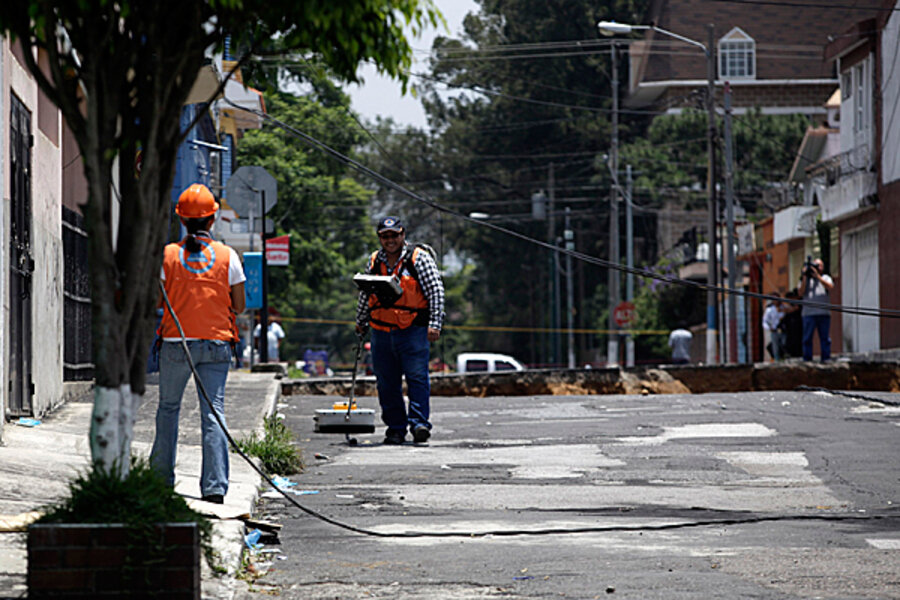Geologists study giant Guatemala sinkhole left in wake of Tropical Storm Agatha
Loading...
| Cartagena, Colombia
Geologists are studying the giant Guatemala sinkhole that swallowed a Guatemala City street intersection during Tropical Storm Agatha on Saturday with an eye toward how to prevent a similar tragedy.
At 66-feet wide and 100-feet deep, the almost perfectly cylindrical hole so far has left more questions than answers.
"I can tell you what it's not: It's not a geological fault, and it's not the product of an earthquake," David Monterroso, a geophysics engineer at Guatemala's National Disaster Management Agency, told the Associated Press. "That's all we know. We're going to have to descend."
IN PICTURES: Guatemala sinkhole
While the Guatemala City sinkhole swallowed an entire three-story building, no one is listed as dead as a result. Residents in the area have moved out and scientists are studying the structural integrity of the hole and surrounding soil, in case it should widen. Meanwhile, the nation is turning its attention to relief operations, in the wake of Tropical Storm Agatha that left more than 180 dead and thousands homeless throughout Central America.
Rains this week will complicate the clean-up and recovery, but Cecilio Martinez, of World Vision in Guatemala City, says that residents who had been in shelters are beginning to return to their homes.
“This morning we are delivering food to those affected,” says Mr. Martinez, by phone from Guatemala City. He says they will also be heading out to the most impacted areas, such as Chimaltenango, to deliver supplies needed like food and blankets. Dozens of roads and bridges have been damaged, slowing the relief efforts.
US helicopters help
US Southern Command’s (SOUTHCOM) Joint Task Force Bravo deployed four military helicopters yesterday from the Soto Cano Air Base in Honduras to support the disaster relief efforts. They are conducting aerial assessments and transporting relief supplies to hard hit areas.
In Guatemala, 152 were reported as dead, with 100 still missing. Chimaltenango, west of Guatemala City, was among the worst hit, as landslides buried entire communities. Sixty people were reported dead there.
Nearly 125,000 people were evacuated in Guatemala.
In Honduras, the death toll stood at 18 and in El Salvador 10. Thousands were also evacuated in both countries. And infrastructure was widely damaged. In El Salvador, authorities estimate that 95 percent of roads were impacted by landslides, and that 179 bridges were damaged.
Wide path of destruction
The storm, the first of the Pacific hurricane season, hit on Saturday near the Guatemala-Mexico border, and died down the next day, but left a wide path of destruction in its wake.
Photos of villagers, covered in mud, and digging through their homes have circulated across the Internet. But no photo has captured the world's attention as much as the sinkhole in Guatemala City.
The sinkhole still remains a mystery, and reconstruction crews are reportedly awaiting to study the plans for the city´s drainage system before moving forward.
The mayor Guatemala City, Álvaro Arzú, said there may be a relationship between the sinkhole and the city's 36-year old drainage system that runs below the surface. He said, according to 21st Century, a Guatemala daily newspaper, that the country’s disaster response agency, CONRED, is using an X-ray like machine to study the earth in the area of the sinkhole.
Residents have voiced concern about how vulnerable they are in the wake of future storms.
But David de Leon, the spokesman for CONRED, says the situation can be address successfully.
Guatemala City suffered a major sinkhole in 2007, and that land is now stable.
Says Mr. de Leon: “It may look like it’s impossible to fix, but we’ve done it before.”
IN PICTURES: Guatemala sinkhole
Related:





